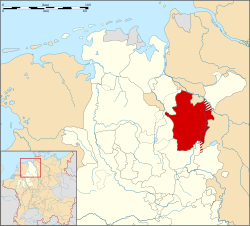County of Hoya
| County of Hoya | ||||||||||
| Grafschaft Hoya (de) | ||||||||||
| State of the Holy Roman Empire | ||||||||||
|
||||||||||
|
County of Hoya (in red) about 1400
|
||||||||||
| Capital |
Hoya Nienburg |
|||||||||
| Government | County | |||||||||
| Historical era | Middle Ages | |||||||||
| • | Henry I Count of Hoya | 1202 | ||||||||
| • | Partitioned between Hoya and Nienburg |
1345 | ||||||||
| • | Reunited under Jobst I of Nienburg |
1497 | ||||||||
| • | Joined Lower Rhenish–West- phalian Circle |
1500 | ||||||||
| • | Count Jobst II turned Protestant |
1523 | ||||||||
| • | Death of Otto VIII | 1582 | ||||||||
| • | Part of Prussia | 1866 | ||||||||
|
||||||||||
The County of Hoya (German: Grafschaft Hoya) was a state of the Holy Roman Empire, located in the present German state of Lower Saxony. It was centered on the town of Hoya on the middle Weser river, between Bremen and Nienburg; the area now belongs to the districts of Nienburg and Diepholz. The largest city of the county was Nienburg.
As of 1582, Hoya was bordered by (from the north, clockwise): The City of Bremen, the Archbishopric of Bremen, the Bishopric of Verden, the Lüneburg and Calenberg subdivisions of Brunswick-Lüneburg, the Bishopric of Minden, the County of Diepholz, the Bishopric of Münster, and the County of Oldenburg.
A first Count Henry at Hoya in Saxony appeared as a liensman of Archbishop Hartwig II of Bremen in 1202. He rivaled with the local Hodenberg noble family at Hodenhagen Castle; their estates on the Weser were gradually acquired by Count Henry and his descendants until 1313. The acquisition of Nienburg led to a long-term conflict with the Bishops of Minden, who suspiciously eyed the steep rise of their comital neighbours.
...
Wikipedia


